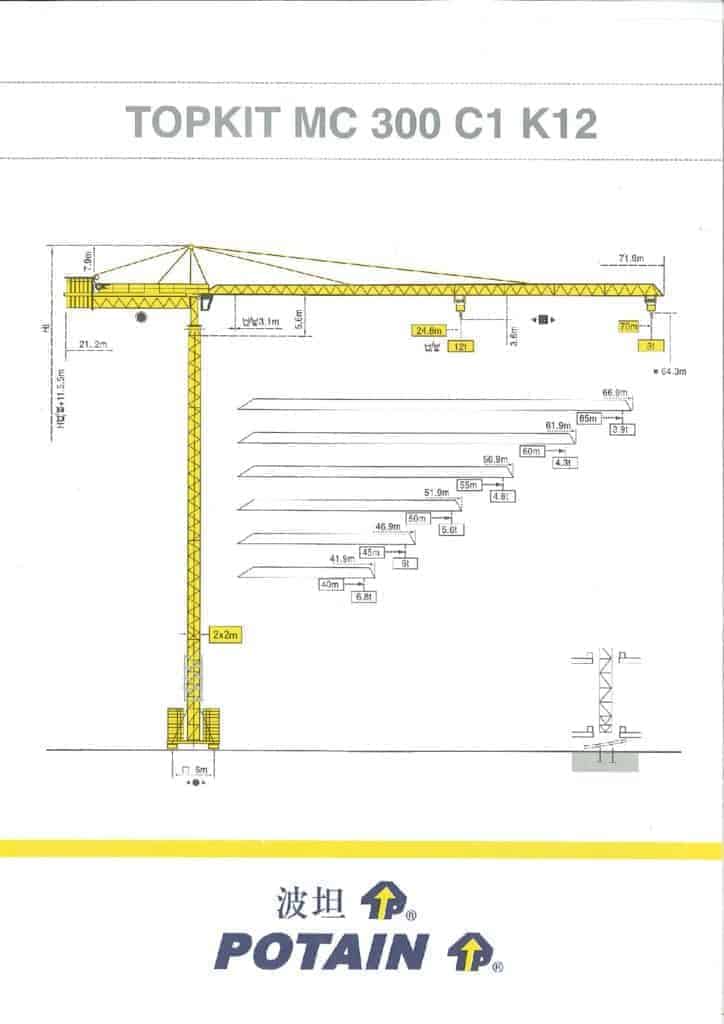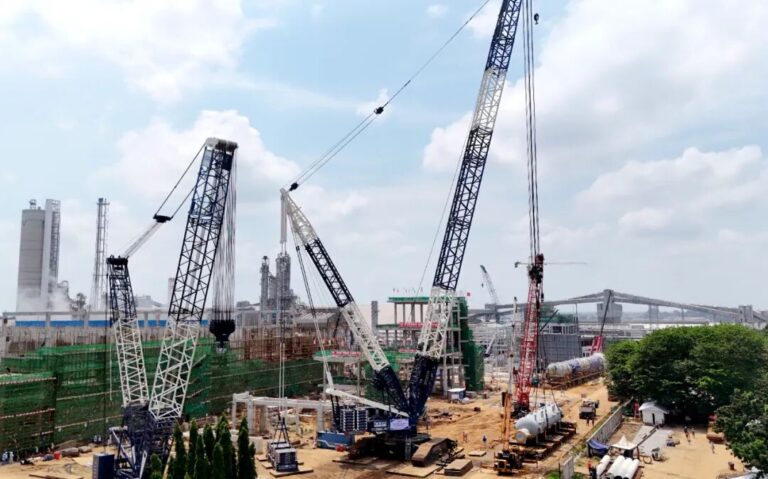
Krøll K1500L
The Krøll K1500L is a 125-ton luffing jib tower crane, specifically designed for wind turbine installation and large-scale infrastructure projects. Competing with the Liebherr 1000 EC-B 125 Litronic, the K1500L stands out with its luffing jib design, offering greater flexibility, reduced working radius, and optimized tower height for high-elevation lifting. The crane features a freestanding capability up to 170 meters (558 feet) without tie-backs, using a rigid M33 monoblock tower system, designed for efficient transport and fast assembly. Equipped with a powerful 154 kW winch, a stiff A-frame with a spring-loaded buffer system, and a tagline system for controlled load handling, the K1500L offers precision, efficiency, and safety in demanding wind turbine installations.
Download Load Chart Here
*Crane Specifications, Load Charts, and Crane Manuals are for reference only.
Contact the crane manufacturer for manuals to operate the crane properly.
Product Description
The Krøll K1500L represents a significant step forward in wind turbine lifting technology, offering a more economical and efficient alternative to traditional crawler cranes. Unlike conventional flat-top tower cranes, the K1500L features a luffing jib design, reducing the required overall tower height while allowing for greater lifting flexibility in confined spaces. Its 125-ton lifting capacity enables it to handle large wind turbine components with ease, making it a preferred choice for renewable energy projects.
One of the crane’s key advantages is its free-standing capability, eliminating the need for tie-backs to the tower. This allows it to erect wind turbines up to 170 meters (558 feet) tall, making it a cost-effective alternative to traditional cranes like the Krøll K1400-125 on a standard M40 tower system. The M33 monoblock tower system maintains the same outer dimensions (3.3m x 3.3m x 7.8m) from base to top, ensuring easy transport while maintaining structural strength.
Ease of Transportation
Engineers have optimized the K1500L for easy transport, ensuring that all components fit within standard road transport dimensions. The A-frame can be folded back onto the machinery deck for easy relocation within a wind farm. For public road transport, the A-frame can be removed, reducing the machinery deck weight from 82 tons to 55 tons. Further disassembly of the hoisting winch brings the heaviest crane component down to just 38 tons, making logistics and transport much simpler compared to traditional heavy-lift cranes.
Shorter Erection Time at Lower Cost
The K1500L is designed for rapid assembly and mast climbing, significantly reducing setup time and associated costs. The 7.8-meter-long mast sections are optimized to require fewer sections for climbing, speeding up the erection process. With two hydraulic rams integrated into the climbing frame, the crane can jack up one tower section per hour.
A separate winch on the erection beam above the climbing frame lifts tower masts into place at speeds of 15 meters per second, allowing for efficient climbing and reduced bolting time. The luffing jib balances the crane during the climbing process, so inserted tower masts do not need to be bolted before lifting the next section, further accelerating the process.
Additionally, only four out of twelve M33 mast sections require reinforcement, allowing for faster assembly with fewer connecting bolts. The rigging process is optimized, with the complete upper body, luffing jib, and counterweight pre-assembled for a single lift. This reduces the assist crane capacity required, with Krøll recommending a 500-ton mobile crane for assembly instead of the 1,200-ton crawler cranes typically used for similar projects.
Challenges & Safety Enhancements
Despite the benefits of a luffing jib tower crane, the steep boom angles required for wind turbine installation present unique challenges, such as an increased risk of over-hoisting due to wind gusts. To address this, Krøll developed a stiff A-frame with a spring-loaded buffer system, ensuring the boom safely stops before reaching the minimum working radius.
Additionally, as wind turbine hub heights increase, the risk of collisions grows. To mitigate this, Krøll engineered a rigid square-section boom with wind sails, allowing the 70.1-meter boom to park safely at a 12.5-meter radius in high winds. The crane is also equipped with AH Industries’ tagline system, featuring two additional winches mounted under the boom foot, ensuring controlled movement of sensitive loads like wind turbine blades.
The K1500L uses a 16m x 16m cross base with height-adjustable cones, allowing for leveling on uneven ground up to a 2% slope. Each corner is equipped with 150-ton hydraulic cylinders, distributing load-bearing pressure evenly across a 7m x 2.4m load distribution mat, ensuring stability in challenging terrain.
The K1500L operates with a four-fall reeving system for all loads up to 125 tons, offering a hoisting speed of 6 meters per minute and a hook lowering speed of 22 meters per minute. Compared to a conventional crawler crane, the K1500L can lift a wind turbine gondola to 179 meters in half the time, significantly improving project efficiency.
Milestones & Industry Adoption
Wind turbine specialist TotalWind became the first owner of the Krøll K1500L, selecting it as a more economical alternative to crawler cranes. While a 1,200-ton crawler crane requires a full mobilization weight exceeding 1,500 tons, the K1500L weighs just 580 tons, reducing transport and setup costs.
The first field test was successfully conducted at a wind turbine site in Poland, where the crane completed its first installation. The entire process—from dismantling, transport, reassembly, and mast climbing—was completed in just four days, demonstrating its efficiency and rapid deployment capability.
Conclusion
The Krøll K1500L is a revolutionary luffing jib tower crane, specifically designed to streamline wind turbine installation while reducing costs and setup times. With its free-standing capability, optimized transport dimensions, fast mast climbing system, and enhanced wind resistance features, it offers a highly efficient alternative to large crawler cranes. With successful deployments and growing industry adoption, the K1500L is set to redefine heavy lifting in the renewable energy sector.















